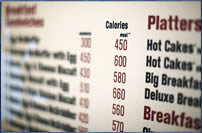Calorie and Kilojoules: What Exactly Are They?
 Calorie counts can be found on food labels and food advertisements.
Calorie counts can be found on food labels and food advertisements.
In fact, because of the growing obesity problem many governments are requiring that companies do even more to make the consumer aware of exactly how many Calories they are consuming.
In many countries outside of the US and UK, food energy is measured by the kilojoule. 1 Calorie (technically kiloCalorie) = 4.184 kilojoules. See the Daily Intake Calculator for daily Calorie or kilojoule requirements.
What is a Calorie?
A calorie is a unit of energy. Technically a calorie is the amount of heat energy required to raise the temperature of 1 gram of water up 1 degree Celsius (1.8 degrees Fahrenheit).
When applied to food, we are actually talking about a kiloCalorie (1000 calories). However the word Calorie (note capitalization) is used in most literature.
The measure of Calories gives us an indication of the potential energy that food possesses. This can easily be calculated with the following formula:
- 1 gram of Protein = 4 Calories
- 1 gram of Carbohydrate = 4 Calories
- 1 gram of Fat = 9 Calories
- 1 gram of Alcohol = 7 Calories
Therefore Calories can be calculated simply by knowing the amount of these three building blocks in the food.
Burning Calories
The body burns calories by a process called metabolism.
This process uses enzymes to break down the carbohydrates, fats, and proteins into materials that can be transported through the bloodstream and used by cells. Here the energy is either used immediately or stored for later. Generally the calories that are stored, are stored as fat.
Therefore if you burn more calories than you consume, you will lose weight. If you consume more calories than your body can use, you will gain weight. (Weight variance could be either muscle or fat).
How Many Calories Do We Need?
When reading food labels, the “Percentage of Daily Intake” variables are based on a calorie intake of 2000 calories per day.
Obviously this is an average – everyone has different calorie averages based on their basal metabolic rate, amount of activity and exercise, genetic predisposition, and gender (among others).
Men typically have higher calorie averages than women (like 2700-2800 calories per day). This is due to a higher proportion of muscle to fat.
Basal Metabolic Rate (BMR) is the amount of energy the body needs to function while at rest (calculate yours here).
This energy is used to keep the heart beating, temperature regulated, and other organs functioning. There are a number of formulas used to calculate BMR – often based around your weight. Note that the thermic effect of food also impacts on your calorie intake. This is the amount of energy your body needs to digest food.
Are All Calories The Same?
As a unit of energy, a calorie is a calorie – no matter where it comes from. However there can be differences in individuals depending on the macronutrient makeup of their diet. This seems to be something that is unique to individuals – meaning you and your friend might have a different response to an identical diet.
Also, some foods do not satisfy us in the same measure. 100 calories of pure sugar will not satisfy our hunger in the same way the a protein/fat combination would (such as an egg).
As you look to change your diet for the better, realize that calorie counting is important but is not the whole picture.
- Buchholz, A. C., & Schoeller, D. A. (2004). Is a calorie a calorie?. The American journal of clinical nutrition, 79(5), 899S-906S.. Link
- Kissileff, H. R., Gruss, L. P., Thornton, J., & Jordan, H. A. (1984). The satiating efficiency of foods. Physiology & behavior, 32(2), 319-332. Link
- Sacks, F. M., Bray, G. A., Carey, V. J., Smith, S. R., Ryan, D. H., Anton, S. D., … & Williamson, D. A. (2009). Comparison of weight-loss diets with different compositions of fat, protein, and carbohydrates. New England Journal of Medicine, 360(9), 859-873. Link
- Wycherley, T. P., Moran, L. J., Clifton, P. M., Noakes, M., & Brinkworth, G. D. (2012). Effects of energy-restricted high-protein, low-fat compared with standard-protein, low-fat diets: a meta-analysis of randomized controlled trials. The American journal of clinical nutrition, ajcn-044321. Link